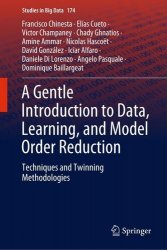 Название: A Gentle Introduction to Data, Learning, and Model Order Reduction: Techniques and Twinning Methodologies
Название: A Gentle Introduction to Data, Learning, and Model Order Reduction: Techniques and Twinning MethodologiesАвтор: Francisco Chinesta, Elías Cueto, Victor Champaney, Chady Ghnatios, Amine Ammar
Издательство: Springer
Серия: Studies in Big Data
Год: 2025
Страниц: 227
Язык: английский
Формат: pdf (true), epub
Размер: 22.3 MB
This book is a gentle introduction to the fascinating world of Machine Learning. We focus in detail on techniques belonging to the even more fascinating discipline of scientific Machine Learning, a subset of the former that tries to extract insight from scientific data. This field of scientific Machine Learning emerges in the context of the so-called fourth paradigm of science. Indeed, science has become increasingly dependent of massive amounts of data generated by large scientific infrastructures. All these data must be collected, curated and analyzed efficiently. This book is devoted to the description of the most important algorithms that allow us to do so.
This book explores the latest advancements in simulation performance, driven by model order reduction, informed and augmented Machine Learning technologies and their combination into the so-called hybrid digital twins. It provides a comprehensive review of three key frameworks shaping modern engineering simulations: physics-based models, data-driven approaches, and hybrid techniques that integrate both. The book examines the limitations of traditional models, the role of data acquisition in uncovering underlying patterns, and how physics-informed and augmented learning techniques contribute to the development of digital twins. Organized into four sections—Around Data, Around Learning, Around Reduction, and Around Data Assimilation & Twinning—this book offers an essential resource for researchers, engineers, and students seeking to understand and apply cutting-edge simulation methodologies
The book is structured into four distinct parts. The first part is devoted mainly—but not only—to Unsupervised Machine Learning techniques. In it, concepts such as the intrinsic dimensionality of a data set, the manifold hypothesis and manifold learning are described and analyzed with examples. The second part of the book is devoted to techniques that we have grouped within the label of “learning”. In other words, we review techniques—in general, supervised—that allow not only to gain insight about the information included in the data, but to make predictions in situations different that those for which they were trained.
Experimental data sets are very often extremely high dimensional. This makes it difficult to manage these data to gain insight, first, and to make predictions, which is the ultimate objective of this book. To overcome this difficulty, order reduction techniques have been developed in the last decades that allow us to simplify these data, by projecting them to lower-dimensional spaces. The third part of the book is devoted to these techniques. We will see how to develop reduced-order models once the intrinsic dimensionality of the data has been unveiled, with a fraction of the computational cost of employing brute data.
Finally, the fourth part of the book is devoted to the construction of digital twins, by leveraging all the just presented techniques. These twins make extensive use of data assimilation techniques, that constitute the main ingredient of this fourth part.
Contents:
Скачать A Gentle Introduction to Data, Learning, and Model Order Reduction
